The brrr-illiant health benefits of cold exposure
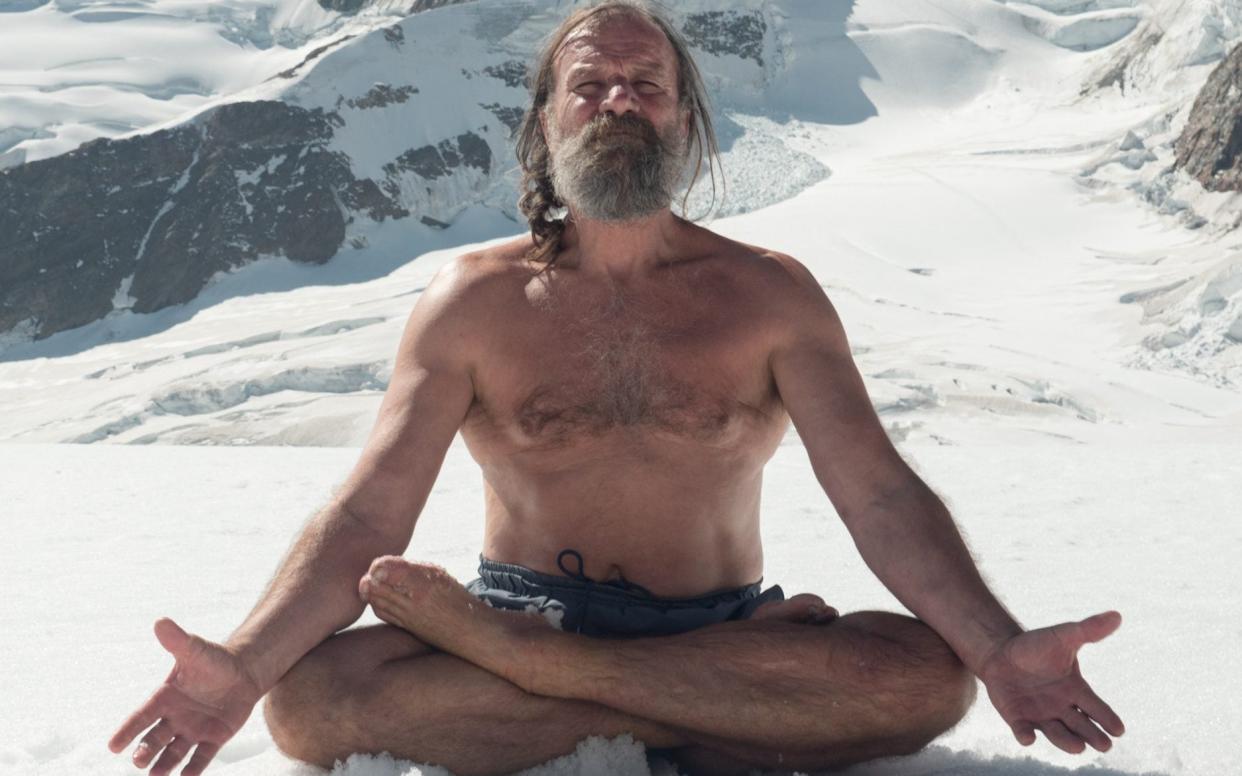
“Good morning!” a sturdy foreign voice booms down the phone. “Is the sun out?”
It is, but it’s certainly not warm. I know because I’m on my balcony, the only place I’ve been able to get phone reception while working from home in 2020. My interviewee would probably disagree with me about how cold it is. The energetic voice on the other end of the line is none other than the Iceman, Wim Hof, fresh from a 20-minute swim in his unheated pool. He only uses it when it’s cold enough in winter; the rest of the time he’s chilling out in his chest freezer at home in the Netherlands.
“I get the electricity going overnight so it’s all frozen up and then for four days I’ve got ice water,” he says with a volubility that’s hard to match.
If you aren’t already a devotee of the Dutchman’s mantra that “a cold shower a day keeps the doctor away”, then you may have at least heard of one of his epic feats of endurance. Hof has set multiple Guinness world records; from the farthest swim under ice, to the fastest barefoot half-marathon on ice and snow. No anomaly of nature (scientists meticulously compared his genetics with that of his more sedentary twin brother and found no differences), he attributes these feats to his Wim Hof Method, a combination of frequent cold exposure, focused breathing techniques and meditation.
A lifetime of following his own path, discovering yoga and pranayama as a teenager and then stumbling into his first blissfully cold swim aged 17 means that at the age of 61 he has more brown adipose fat (which breaks down blood sugar – glucose – and fat molecules, allowing the body to create heat) than a man half his age. Speaking on the phone, he admits: “I actually don’t like the cold, but it’s there, so I make use of its benefits.”
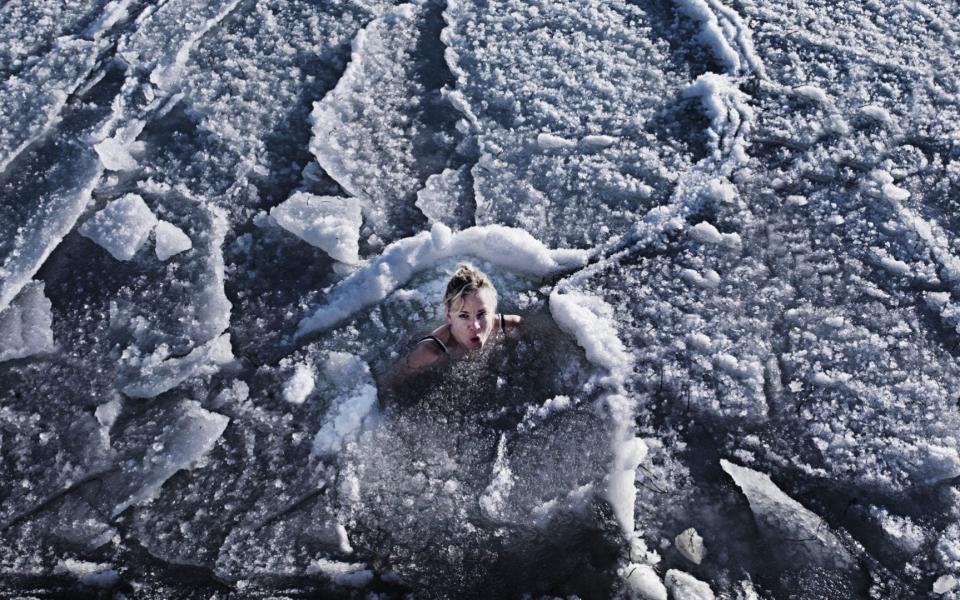
Those positives are slowly becoming understood by the scientific community. Here is how embracing the winter chill could help fight obesity, depression and illness.
Ten thousand years ago, we were rampaging around the plains, hunting in little more than an animal’s hide. Now we wrap ourselves up in mountain-grade down jackets just to walk the dog. We whack up the heating before even the first hint of frost, and talk about the poor circulation in our hands. A friend once met me in the depths of winter for a drink in a bar, only to take her thick coat off to reveal a hot water bottle underneath so she could withstand the journey.
Wim Hof, who wears shorts and a T-shirt throughout the winter, labels this kind of behaviour “comfort zone behaviourism”, and it’s believed by some health experts that it is doing us more harm than good. Humans are homeotherms, seeking a relatively constant core temperature. Homeothermy, however, is best achieved if challenged by cold or heat exposure. It’s why we observe a number of health benefits from cold open-water swimming, saunas, and exercise.
While it’s instinctive, for our own safety, to avoid the cold, the outcome in the modern world is that we’ve arguably retreated too far into the warmth and subsequently alienated ourselves from our psychology to the point where, as Hof says: “We think you’ve got to be tough to go into the sauna and the cold water, which isn’t true. It’s about bringing the cardiovascular system to its rightful condition. We are weakening ourselves.”
With lockdown restrictions on socialising indoors, we’ve all been spending more time in parks and woods, getting a taste of what the Norwegians call friluftsliv (“open-air life”), with the known benefits to our mood and mind, as well as our vitamin D levels and serotonin and melatonin production. However, if you’ve been swaddling yourself in layers, you will be missing out on the benefits of cold exposure.
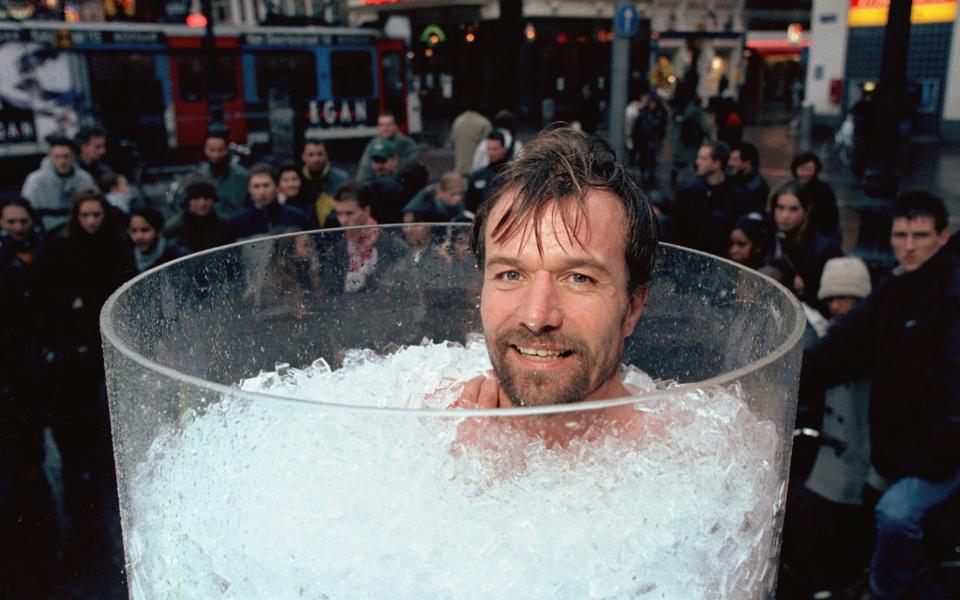
The human body has its mechanisms for adjusting to the cold; the hypothalamus, which acts as the body’s thermostat, responds to signals from the skin by causing vasoconstriction of the blood vessels, reducing blood flow to the extremities to protect the core and prevent heat loss. Wearing a big coat means you are covering up the body’s thermoreceptors and inhibiting its ability to self-regulate temperature. By doing so, we miss out on exercising the muscular tone of the vascular system.
“And do you know who’s paying for that?” says Hof. “Our heart is. When these little vascular muscles are not tuned up, not working at an optimised condition, our heart is forced to pump much more, deeper and stronger, to get the blood flow through. This puts undue stress on our heart on a chronic basis. That’s one of the primary reasons, together with diet and exercise, why cardiovascular-related diseases are the number-one killer in our society.”
Hof might be a maverick, and not everyone is on board with his claims, but many scientists agree that our comfort behaviourism is contributing to poor health. Until recently, it had been assumed that brown fat decline was an inevitable part of getting old. However, studies have shown that we can regrow brown fat through cold exposure.
Dr Barbara Cannon, professor emerita of physiology in the department of molecular biosciences at the Wenner-Gren Institute, Stockholm University, Sweden, recalls growing up in the Peak District in the 1950s, where winters were so cold she could write her name in the layer of frost on the inside of the window.
“I was cold-exposed,” she says. “I’m sure my parents had maintained their brown fat, too, as a result. But as we’ve got more comfortable by having central heating, we’re not exposed to any change in temperatures at all.”
Brown fat is considered preferable to white fat (the latter being linked to obesity) and Dr Cannon’s research has demonstrated that metabolism in brown fat is increased when adult humans are exposed to cold.
“If you’re out in the cold, you’ll have a response that’s rather like exercise, in that you’ll increase your heart rate,” says Dr Cannon. As a result, cold exposure has been hailed in some quarters as a weight-loss tool. Researchers around the world are working to harness brown fat’s activity in order to treat obesity, diabetes, and other metabolic disorders – although advice to the elderly and those with pre-existing cardiovascular conditions is still to take care in colder weather.
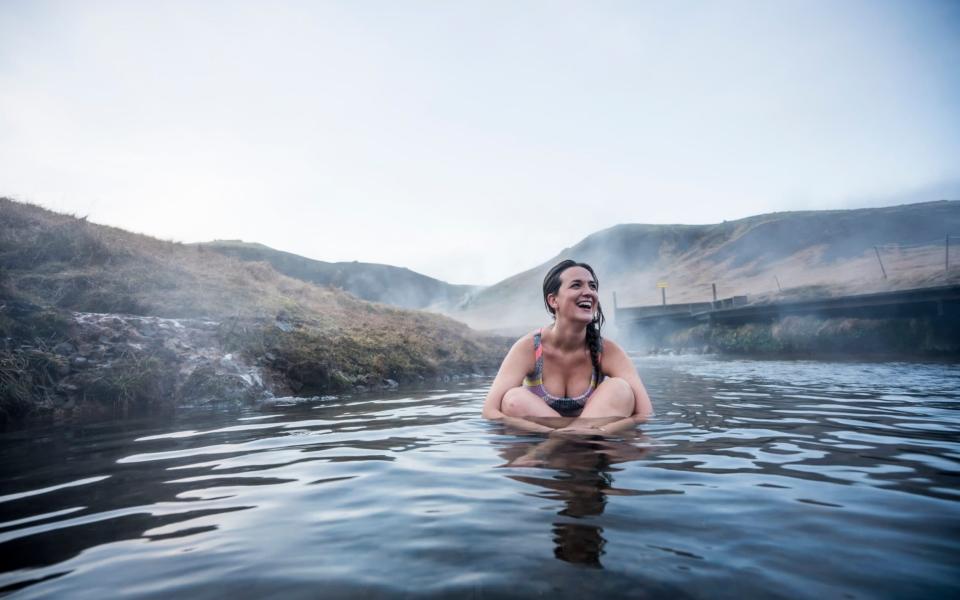
The link between cold exposure and immunity to infection is also being studied. Exposing yourself to limited stress is called hormetic stress exercising – the theory being that something that produces harmful biological effects at high doses produces beneficial effects at low doses. Seemingly, cold exposure can make the body more alert and prepared; and – it’s claimed – can enhance our ability to fight infection.
In 2014, a study at Radboud University Medical Center in the Netherlands took blood samples from Hof before and after his regimen of breathing, meditation and an 80-minute full-body ice bath, and found that afterwards he had reduced levels of proteins associated with the immune response. He was then injected with an endotoxin that would normally stimulate a rapid immune response. Most subjects responded with flu-like symptoms, with affected cells releasing cytokines. Hof, on the other hand, had no flu-like symptoms and half as many cytokines as control subjects. In a further study, he trained some volunteers in the Wim Hof Method for a week; they, too, had reduced symptoms.
The same year, Dr Marius Brazaitis, a scientist at the LSU Institute of Sport Science and Innovations in Lithuania, conducted a study where a group of healthy men spent three hours a day in baths filled with 14C (57F) water. By day 20, the men’s shivering, which is the human body’s initial response to cold, had more or less stopped. Their metabolisms and heart rates still sped up in response to the cold-water bath, but their blood vessels no longer constricted and their skin temperature didn’t drop the way it had before. Fascinatingly, their blood samples contained fewer markers of cold-induced stress and immune-system activity.
“We’ve shown you have better circulation when you are exposed to the cold,” Dr Brazaitis tells me. “And our subjects afterwards reported that, that year, they didn’t catch any colds. It seems that they had some sort of resistance to illness.”
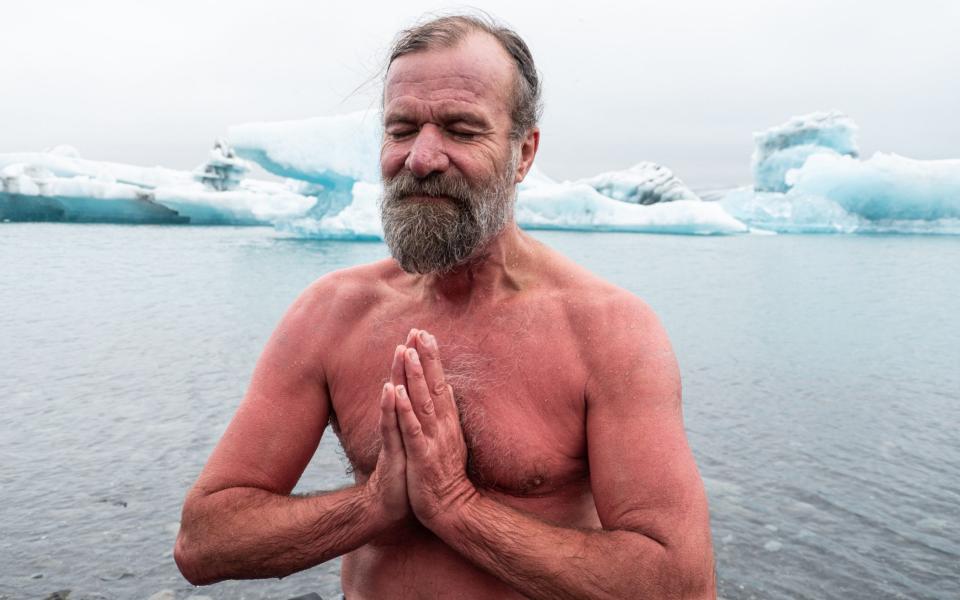
“Immunity” has been the word on everyone’s lips during the 2020 coronavirus pandemic. Fortunately, we don’t have to have to go through the same level of discomfort to replicate some of the benefits; although there are companies selling “cold vests” to stimulate the growth of brown fat. Hof has a far more accessible solution; “Cold showers!” He recommends ending a warm shower with 30 seconds of cold water. Gradually, your tolerance will lengthen, with Hof saying all of us should be able to last for two and a half minutes in a cold shower. He feels strongly that they are a powerful tool to support our immune system.
“My message to the public is if you want to boost your immune system, use these specific breathing techniques, which do no harm at all, and actually you feel kind of high.”
While it would be prudent for those who are older to proceed with caution (and if you have a pre-existing cardiovascular condition you should consult your doctor before trying any cold therapies), Hof says his oldest WHM participant is 98 and is part of a programme in retirement homes in the United States.
The benefits of the cold don’t stop there. As well as stimulating metabolic activity and enhancing the immune system, when you are cold-acclimatised less adrenalin is released during exposures, meaning less stress and less inflammation. You also get a hit of dopamine, endorphins and serotonin. No surprise, then, that Hof is a strong believer that it can hold depression at bay, and is currently working with the University of San Francisco on a study relating to depression.
“With a little activation through the cold we are able to rebalance ourselves and we get a sense of control of ourselves again,” says Hof. “It makes sense because it feels so good.”
You may want to go deeper into the WHM method but, for most of us, even trying to turn the temperature down on the shower will be challenging enough. And that is OK. Cold exposure for you could be as simple as leaving the scarf at home. Because, as Hof stresses, it’s not about being tough, it’s about getting back into the natural conditions of our cardiovascular system.
Boudicca Fox-Leonard takes her sun salutations outdoors
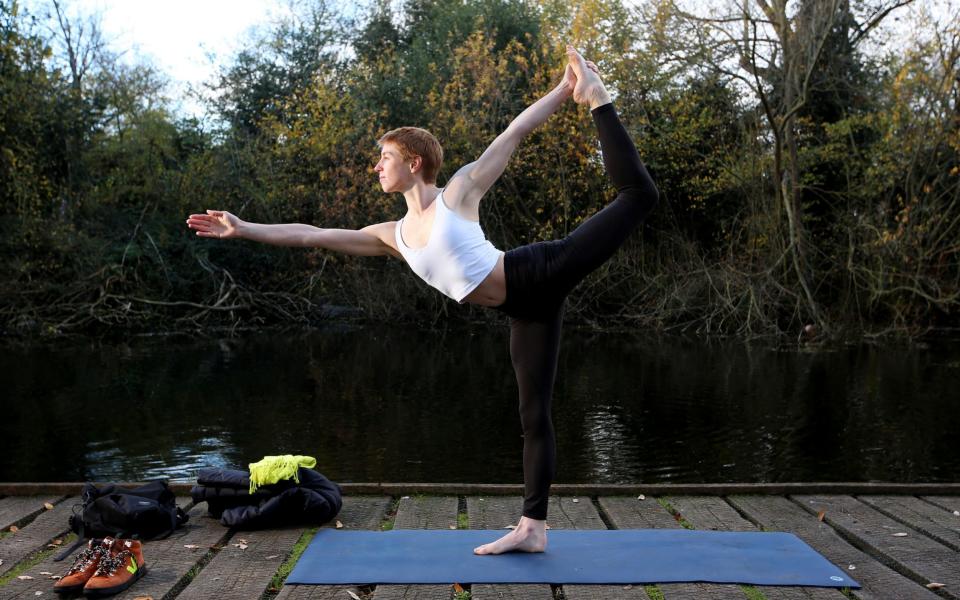
During the summer, the park outside my flat in East London was a Where’s Wally of people swinging kettlebells, sparring in boxing gloves and Trx training from poor saplings. Now the trees are bare, the park is too. We’ve entered jogging season, where red-nosed runners quickly warm up their bodies and subsequently return home with the cold ringing in their ears. I have no motivation for that. Instead I do my yoga practice.
During my interview with Wim Hof, he told me how on his retreats in Poland, his students do yoga indoors before he tells them: “OK, it’s now time to go out into the snow and do them.” “Anything done outdoors has great adaptive power for vascular fitness, which we in the West hate” he said.
During the first five minutes, I struggle to focus on anything but the cold. It remains the case for the entirety of the class. Savasana, the final pose, comes not as a soothing relief but as its literal meaning; corpse pose. I feel frigid. However, I have moved from discomfort to curiosity, observing the slow warming of my muscles and my accommodation with my icy atmosphere.
I try again the next day. I keep my practice simple, building heat with sun salutations and a few standing poses. I feel a focus and concentration that is lost in my day to day. I feel grounded, primal and present. This isn’t about striking fancy poses (yes, there were some for the photos) but doing the inner work; the true meaning of yoga.
The Wim Hof way to get warm
Are you one of those people who feels cold all the time? Would you like to be able to warm your body even when you don’t have access to an external heat source? If so, the following exercise can be done to activate brown fat tissue (or brown adipose tissue — BAT), which is capable of energy combustion. It will also activate the intercostal muscles, which run between the ribs and help move the chest wall during respiration. Activating them also generates heat.
Do as follows:
Sit down.
Inhale slowly and deeply five or six times, letting your breath go naturally each time.
Inhale fully, then relax to exhale.
Inhale fully and this time hold your breath. Tense your upper-back muscles and chest while you hold your breath — but don’t tense the head. Keep your jaw relaxed.
After no more than five seconds, let go. With practice, you will feel the heat flowing down from your neck to your whole body. Everybody is different, but with practice, you will feel the heat.
Tom Ough goes coatless for his daily walk in Kennington Park
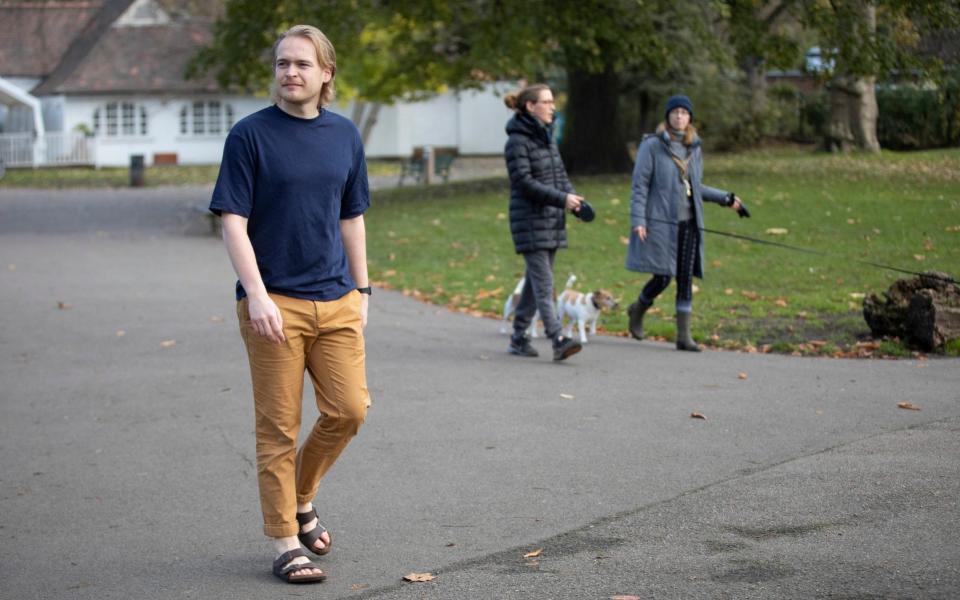
My Wim Hof challenge was an entry-level one: taking a coatless walk each morning for a week. Like many nerdish young men who like to sleep with the window open in any weather, I already nurtured a quiet appreciation of Hof, not least because his philosophy entirely vindicates my girlfriend-riling preference for a low level of household heating.
On those grounds, taking my morning walk around Kennington Park in one or two fewer layers than usual seemed exactly what it was: a walk in the park. For the first few days (when this photo was taken) that’s what it was. Although my T-shirt was skimpy compared with the extra layers worn by other walkers, I didn’t feel much of a difference. I decided to force the issue by ending my usual warm shower with a minute-long blast of freezing cold. Hof writes that the switch from warm to cold exercises the minuscule muscles in your vascular system and, alongside awakening you to “the physiological power and neural activity of your own body”, accustoms you to yet colder conditions.
Maybe that helped me on the last day of the challenge, a day when it really was cold. A grey mist hung in the morning air, making the leafless trees look spectral. As I emerged from the house, a passing walker chuckled and said I’d be freezing. In the end, I felt invigorated, and I could feel with my body as well as know in my mind that hormesis, the practice of exposing ourselves to mild stressors in order to improve our body’s durability, is – at least when it comes to temperature – a powerful intervention.
My girlfriend will disagree, but I presume that incurring her annoyance, since it involves exposing myself to another mild stressor, is simply another form of hormesis.
Wim Hof’s ice-water bath method for warmer hands and feet
“People who often complain of cold hands or feet suffer from poor vasoconstriction and dilation. The muscles around the veins in their hands and feet do not function well and need to be retrained. This ice bucket exercise helps.”
Fill a bucket with one-third ice and two-thirds water.
Redirect your mental focus to your hands (or feet).
Place your hands or feet into the ice bucket.
Hold your hands or feet in the bucket for two minutes. They should start to feel warm instead of cold.
Remove your hands or feet from the bucket, but keep focused on them.
Shake them out several times to encourage the blood flow into your newly awakened extremities.
Why it works
“Your blood vessels constrict at first. But they relax when your blood reaches 10C (50F), allowing warm blood to flood in. You are resetting the physiology in your extremities. Adaptation occurs quickly. After a couple of days of this, you will find your extremities aren’t so cold.”
Anna Turns ditches her wetsuit in Salcombe
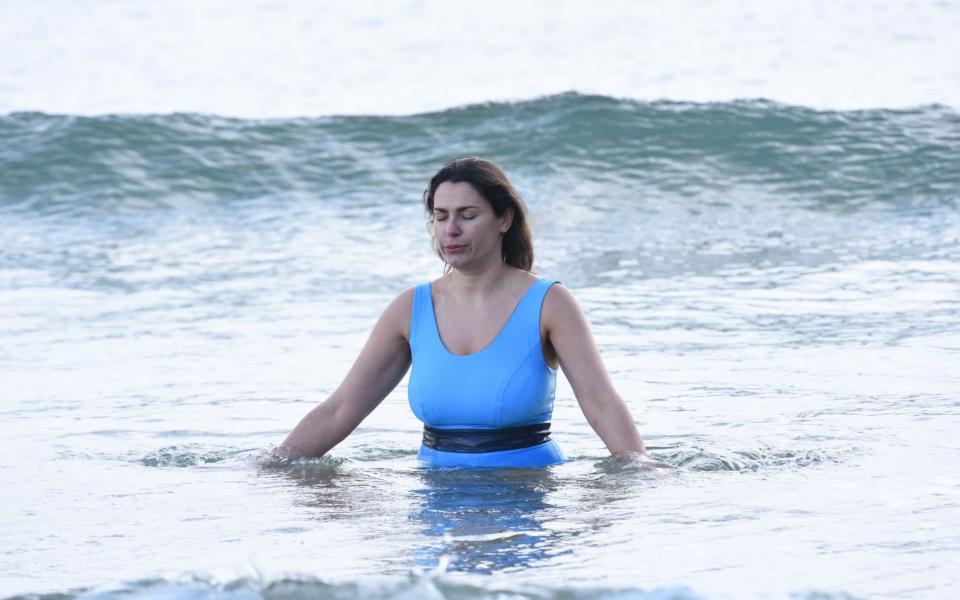
If I ever swim in the sea in November, it’s always in a wetsuit, thermal rash vest, wetsuit socks and gloves with a tow float, goggles and two swim hats. So the prospect of ditching all that kit is nerve-racking for two reasons – not only will I feel more exposed to the cold but also more exposed to view, without the anonymising effect of a wetsuit.
As I tentatively step into the sea – a balmy 13C (55F) – I begin to focus. With every inhalation, I become more present and notice the sensation of the cold waves splashing against my legs. With every exhalation, I try to relax and overcome the desire to retreat to the beach. I realise that I can survive this – the cold won’t hurt me, it’s something I must embrace. After slowly walking into deeper water, I swim for just a few short strokes with my head up but I’m in. Afterwards, the skin on my arms tingles and I feel more alive.
The following morning, I’m back at the tideline at the crack of dawn in preparation for extreme ice cream headaches. As I take 30 slow, conscious breaths, I gaze at the fishing boats heading out to sea. Once I reach waist depth, I place my hands on the waves and the chill makes my rib cage contract. But I come back to my breath, stay present and begin to feel more at ease. Once I’m swimming, I’m determined to fully submerge.
It’s refreshing, awakening and quite liberating – I’m starting to understand that this cold water immersion is making me more confident, focused and aware that I can push myself out of my comfort zone and be more than all right. I’m buzzing for the rest of the day.
On the third day, I take my goggles, unsure whether I’ll find my flow and be able to settle into a rhythmic calm front crawl but keen to try. These swims go beyond functional exercise though – cold water immersion is my meditation. My senses are heightened and it’s not an escape, it’s about coming back to my breath, feeling every inch of my skin as I swim and fully inhabiting this body. For the rest of the day, I feel invigorated and it’s like an addiction. Who needs neoprene anyway? I can’t wait to get my next hit of vitamin sea.

